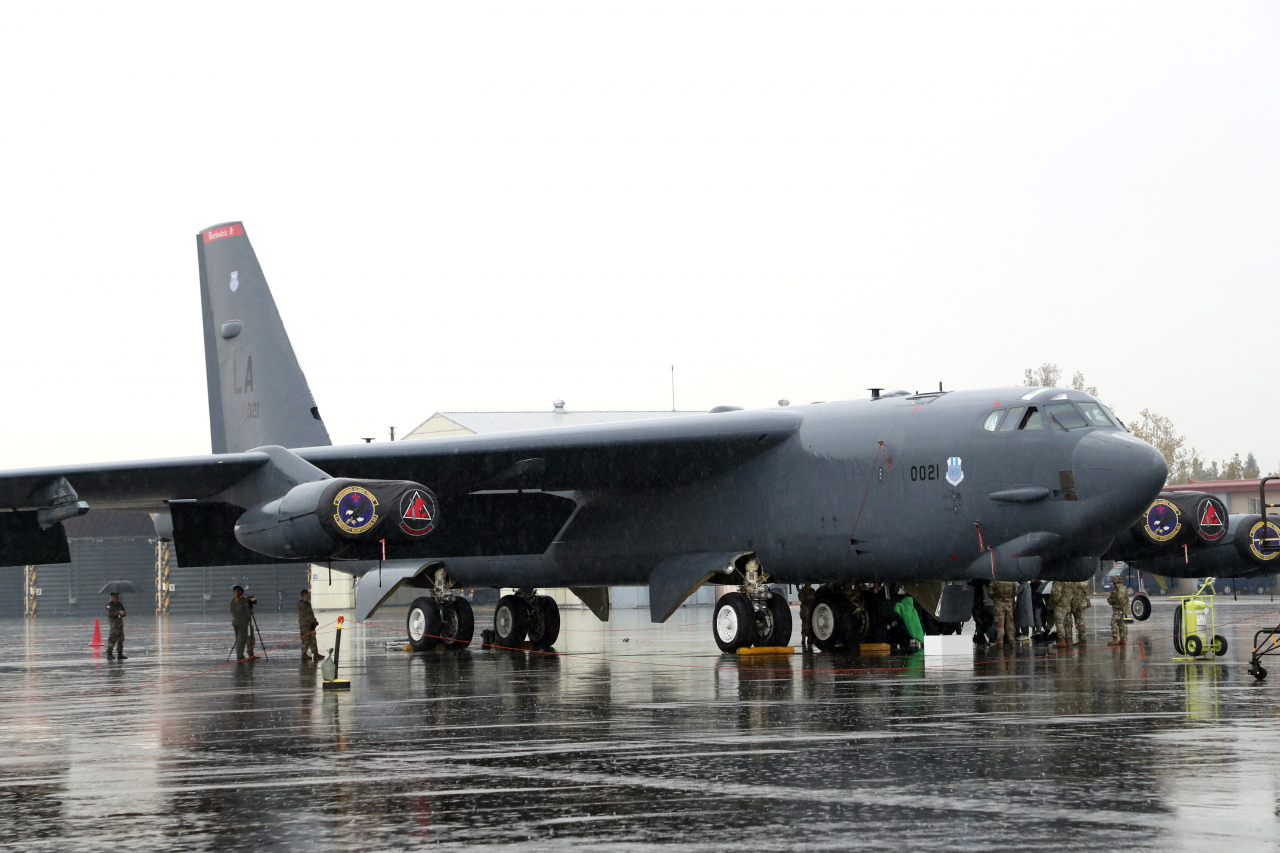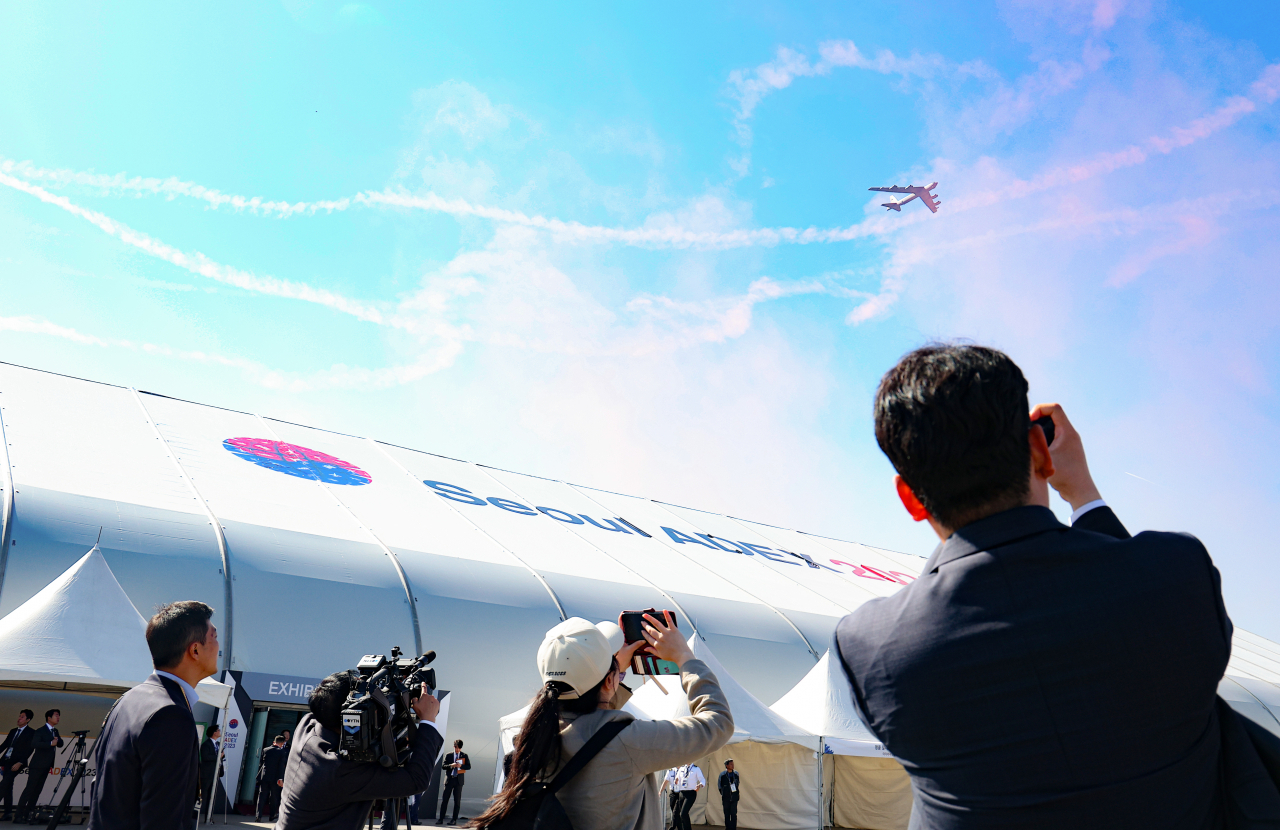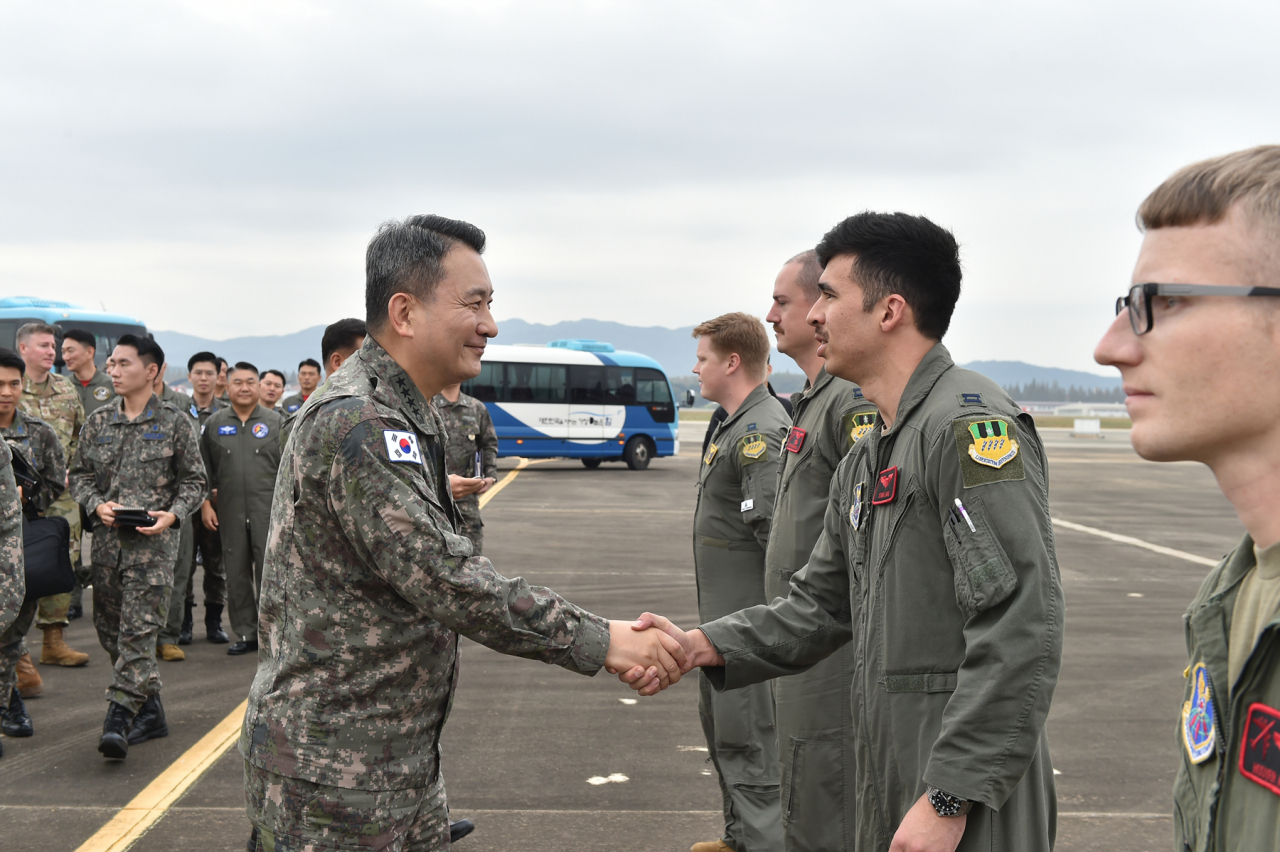 |
Chairman of the Joint Chiefs of Staff Kim Seung-kyum (center, front row), South Korean Air Force Chief of Staff Gen. Jung Sang-hwa (fourth from left, front row) and US Pacific Air Forces Commander Kenneth Wilsbach (fourth from right, front row) pose for a photo in front of the nuclear-capable US strategic bomber B-52H that landed in Korea for the first time, at the Air Force base in Cheongju, North Chungcheong Province, Thursday. (Joint Chiefs of Staff) |
By Ji Da-gyum and Joint Press Corps
CHEONGJU AIR BASE, North Chungcheong Province — The United States Air Force's nuclear-capable B-52 strategic bomber on Tuesday made its first-ever landing at a South Korean air base. The touchdown of the long-range heavy bomber underscores the US' unwavering commitment to the defense of its treaty ally, amid escalating missile and nuclear threats posed by North Korea, according to the US Air Force.
"It is part of our demonstration to the Republic of Korea, its people, and its government that we stand by our allies, that we have an ironclad commitment to secure the peace and stability of this region," Maj. Rachel Buitrago, public affairs director of the US 7th Air Force, said Thursday at the South Korean Air Force’s base in Cheongju, North Chungcheong Province.
The B-52H Stratofortress is the key asset of demonstrating US extended deterrence, which is the US commitment to deter or respond to coercion and attacks on US allies and partners by using the full range of its military capabilities, including nuclear, conventional, missile defense and other advanced non-nuclear capabilities.
The B-52s have also effectively carried out crucial missions overseas, including in Operation Enduring Freedom and Operation Iraqi Freedom. B-52 aircraft executed around 1,800 combat sorties against Islamic State group forces in Syria and Iraq, significantly contributing to the reduction of the jihadist group's presence in the region.
"In terms of the combat capability, we have various mission sets such as strategic attack, air interdiction, close air support, and obviously we also support the nuclear enterprise," Capt. Sabin Park, bomber commander of the 96th Bomb Squadron and a B-52 pilot, said at the air base.
"So we are very flexible, and I think the unique thing about the B-52 is the fact that we can support so many different mission sets."
 |
A US Air Force B-52H strategic bomber rests on the tarmac, stationed at a South Korean Air Force base in the city of Cheongju, North Gyeongsang Province.(Kookbang Ilbo) |
The B-52 features remarkable specifications, including a wingspan of 56.4 meters and a length of 48.5 meters, which is slightly shorter than the swimming pool used in the Olympic Games, measuring 50 meters in length. It also boasts a height of 12.4 meters and a weight of approximately 83,250 kilograms.
Lt. Col. Vanessa Wilcox, commander of the 96th Bomb Squadron in charge of flying and operating B-52 strategic bombers, said the significance of the inaugural touchdown is more than enhancing interoperability with South Korean forces.
"The best way to say it is that the opportunity to work and integrate with our ROK partners is something we cannot possibly achieve unless being here on the ground," Wilcox answered, referring to South Korea's official name, Republic of Korea, when asked by The Korea Herald.
"It really provides a totally different opportunity that we would not have if we were not here physically with them."
 |
A B-52 strategic bomber flies during the opening ceremony of the Seoul International Aerospace & Defense Exhibition (ADEX) 2023 at Seoul Air Base in Seongnam, south of Seoul, on Tuesday (Yonhap) |
The historic landing took place as part of the celebration of the 70th anniversary of the South Korea-US alliance, established through the signing of a mutual defense treaty in October 1953.
The touchdown coincided with the B-52's inaugural flyover at Seoul ADEX 2023, South Korea's leading aerospace and defense exhibition. The event's primary objective is to exhibit the nation's domestically produced weaponry and military capabilities in response to the ongoing North Korean threats, reaching out to the general public.
"One of the greatest parts of being in the air show is that it shows the whole public of Korea that we were here and that we were able to fly from the United States. We can't talk about where in the United States because of security reasons, but we have that extended reach capability," Buitrago said when asked by The Korea Herald about the significance of the participation.
"At the invitation of the event organizers and the Republic of Korea, we were proud to be able to participate in that to demonstrate our commitment. It shows that if we are needed we will be here."
The B-52 Stratofortress on Tuesday conducted a flyover during the opening ceremony of Seoul, with South Korean President Yoon Suk Yeol in attendance. The US strategic bomber is scheduled for another flyover during ADEX 23, which ends Sunday.
What's particularly noteworthy is the role of Capt. Sabin Park, who was born in Masan, South Gyeongsang Province, and then later became a US Air Force pilot. He will be piloting the B-52 strategic bomber over South Korean airspace.
“It's a lot more meaningful because I have that Korean background and tying it all together with the fact that I'm an American and being born in Korea,” Park said.
"I think it's just amazing to see that there's cooperation and an effort to really show that the US and Korea are working together."
 |
South Korea's Joint Chiefs of Staff Chairman Gen. Kim Seung-kyum (left) encourages operational officers of a US B-52H strategic bomber at a South Korean combat squadron on Thursday. (Joint Chiefs of Staff) |
South Korea's Joint Chiefs of Staff on Thursday said the deployment of the B-52 strategic bomber to the Korean Peninsula serves the purpose of regularly demonstrating the US commitment to extended deterrence for South Korea and strengthening the viability of extended deterrence.
The landing and flyovers of the B-52 Stratofortress also followed an agreement between Yoon and US President Joe Biden to enhance the regular visibility of US strategic assets, as outlined in the historic Washington Declaration signed on April 26.
"The deployment of the B-52H strategic bomber is that case that reaffirms the United States' commitment to the ironclad defense of the Korean Peninsula and extended deterrence and capabilities to put them into action in the face of enemy's advancing nuclear threats," Gen. Kim Seung-kyum, South Korea's JCS chairman, said Thursday morning during his visit to the air base.
"The South Korea-US alliance will persist in pursuing 'peace through strength' based on overwhelming capabilities. If the enemy uses nuclear weapons, the North Korean regime will face demise."





![[Herald Interview] How Gopizza got big in India](http://res.heraldm.com/phpwas/restmb_idxmake.php?idx=644&simg=/content/image/2024/11/20/20241120050057_0.jpg)

